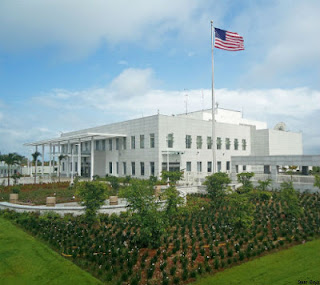State Department Photo
Office of the Spokesperson
Department of State
Washington, DC
December 6, 2012
In an important symbol of America’s commitment to an enduring
friendship with the Gabonese Republic, U.S. Ambassador to Gabon, Eric
Benjaminson, dedicated the new U.S. Embassy in Libreville today. Gabon
Prime Minister, Léon M’ba; Assistant Secretary for Administration, Joyce
Barr; and Bureau of Overseas Buildings Operations (OBO) Managing
Director, Rodney Evans, participated in the ribbon-cutting and official
opening ceremonies.
Occupying a ten-acre site in the Sabliere neighborhood, the $107
million multi-building complex provides a centralized location for the
mission, as well as a state of the art, environmentally sustainable
workplace for embassy personnel.
Sorg Architects of Washington, DC, is the architect of record and
B.L. Harbert International, LLC of Birmingham, Alabama constructed the
project.
The Embassy’s permanent art collection features works by celebrated
Anglo-American, African-American, and Gabonese artists, curated by the
Office of Art in Embassies. The artworks are organized around a theme
relating to creatures of the forest – a formative force in Gabonese
life. The collection also includes a commemorative portrait of Dr.
Martin Luther King, Jr., the namesake of the road in front of the new
embassy.
The new facility incorporates numerous sustainable features, most
notably energy efficient building systems, low-flow water fixtures, and
recycled materials. The facility has been registered with the U.S. Green
Building Council for Leadership in Energy and Environmental Design
(LEED®) certification.
Since 1999, as part of the Department’s Capital Security Construction
Program, OBO has completed 95 new diplomatic facilities and has an
additional 40 projects in design or construction.
OBO’s mission is to provide safe, secure, and functional facilities
that represent the U.S. Government to the host nation and support our
staff in the achievement of U.S. foreign policy objectives. These
facilities should represent American values and the best in American
architecture, engineering, technology, sustainability, art, culture, and
construction execution.
Subscribe to:
Post Comments (Atom)

No comments:
Post a Comment